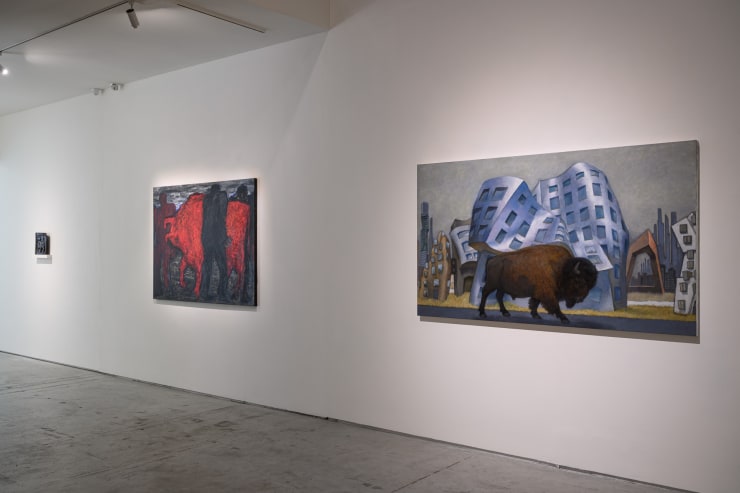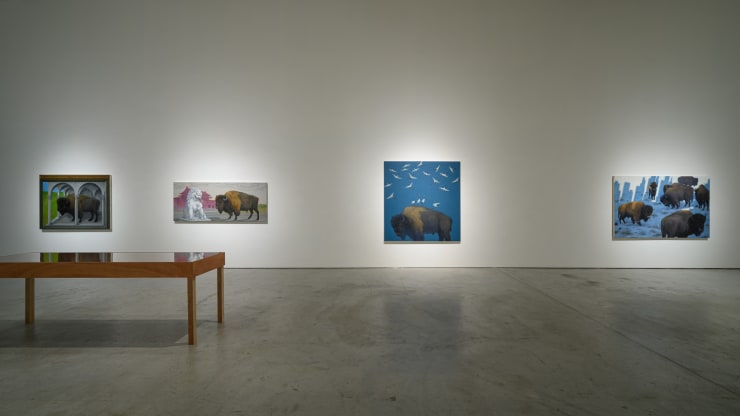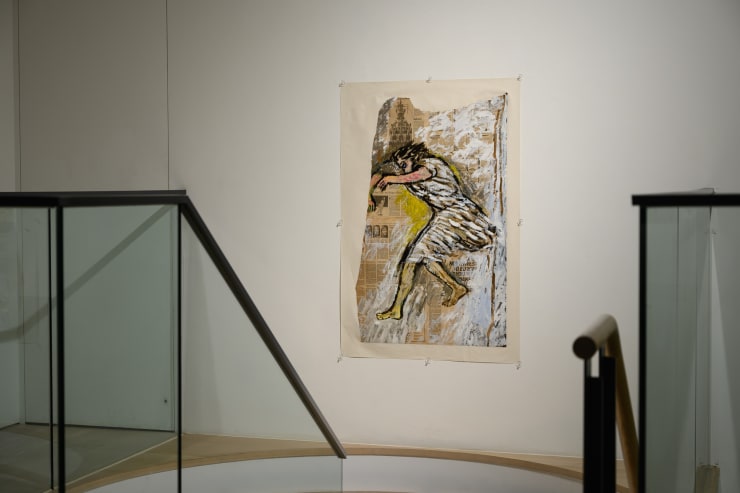If Bison Can Dream: Zhang Hongtu Solo Exhibition
If Bison Can Dream: Zhang Hongtu Solo Exhibition
- Press Release
- Installation Shots
- Publications
- Videos
-
Share
- X
- Tumblr
Dates
27 NOVEMBER 2021 - 22 JANUARY 2022
Reception
27 NOVEMBER, 4:30 p.m.
Tina Keng Gallery 1F, No.15, Ln. 548, Ruiguang Rd., Neihu Dist., Taipei 114, Taiwan
Projections? Maybe.
Fantasies? Possibly.
But, perhaps, something else.
— The Girl Who Sang to the Buffalo, Kent Nerburn
Four years after his previous exhibition Van Gogh/Bodhidharma, Tina Keng Gallery is pleased to present Zhang Hongtu’s latest body of work in his solo exhibition If Bison Can Dream. As the Year of the Ox comes to an end, this exhibition about the ox is not the result of an intentional thematic alignment, or a mere coincidence. Throughout this exhibition, the bison symbolizes the significance of chance encounters during Zhang’s journey of migrating and roaming over great distances.
Zhang’s work is rational yet curious, fierce yet harmonious. He expresses a sense of calm defiance with a fearlessness that defines his aesthetic perspective. After living through the Chinese Cultural Revolution and suffering through the turmoil of the era, Zhang left his home country and moved to New York in the 1980s. Over the years, Zhang has explored a deep cultural lineage between the East and West as he migrated between old and new terrains. The artist channels his personal experiences into a unique hybrid style, often deconstructing, reinterpreting, and juxtaposing familiar tropes and icons — such as traditional Chinese landscape paintings and Impressionist/Post-Impressionist styles. As an advocate for continual aesthetic experimentation, Zhang centers his practice on a philosophy of “taking good fortune as a teacher” and “embodying the spirit of the landscape.” By challenging established conventions and conflating elements that are typically kept separate (such as ink and oil paint), Zhang forges a new aesthetic vocabulary that he uses to express his ultimate concerns for humanity and the natural ecosystem. Within this conceptual framework, he painted the monkeys who wander indifferently through desolate landscapes in his “Shanshui Today” series, the wise and compassionate Zen Bodhidharma in his “Van Gogh/Bodhidharma” series, as well as his current “Bison Roaming” series.
Zhang was sketching animals at the Beijing Zoo in 1962 when he encountered the bison for the first time. He saw two large bison with brown-black coats enclosed in a space not much larger than their bodies, and their confinement in the man-made environment seemed entirely unnatural. As he sketched the animals, he imagined what it would be like to see them living in their natural, wild habitat. In 2018, Zhang’s imagination came to life during his first chance encounter with American bison roaming the tallgrass prairies of Kansas. The idyllic scene induced a flashback to when he first laid eyes upon a bison at the Beijing Zoo, and that chance encounter sparked an instant connection between the two moments in Zhang’s memory, spanning 56 years and thousands of miles. Zhang’s vision of the animal confined in custody was then replaced by the image of the bison roaming under sunny blue skies and endless plains, with the spirits of their ancestors looking over them from beyond the mountains. As he watched the bison slowly marching across the grassland, one bison returned his gaze. The connection he felt while looking into its eyes made Zhang realize that they were both of the same earth and of the same nature, and the powerful silence they shared in that intimate moment produced a resounding echo.
Throughout the history of North America, the Native Americans relied on bison for survival, using their meat for sustenance and their hides to keep warm for tens of thousands of years. When the colonists invaded Native territories as they built the Transcontinental Railroad, their indiscriminate killing of bison robbed indigenous communities of their economic autonomy and their means of survival. The blood and sweat of Chinese immigrant workers in the 19th century are inextricably linked to those railroad tracks, and their fates were also linked to those of the Native Americans and the bison. Seen as such, each wooden railroad tie represents a life lost, human and animal, in the process of early American industrialization.
Zhang pays respect to the great beast with a gentle command to the viewer in his work When You Come Before the Image of the Bison Take Care That You Do Not Neglect To Say an Ave. The artist even depicts the bison as the protagonist of an annunciation scene, consecrating the animal with a sense of godhood. Only roughly 300 bison remained at the end of the 19th century, and while there are around 360,000 bison alive today, they are only able to survive under protective captivity in wildlife sanctuaries. Despite being a large and extremely powerful creature, the American bison remains an endangered species. If a bison were to escape its sanctuary, it would certainly suffer the fate of being hunted. In an artist statement, Zhang reflects: “If bison can dream, they must dream of the wild plains where their ancestors roamed every day. While working on my art during the Covid-19 epidemic, I was not only isolated from others; like the bison, I found myself isolated from true wilderness and all of its freedom. The only thing I could do was imagine it through my art.” This series encapsulates both remnants of history and the gradual passage of time. Through this exhibition, Zhang presents his reflections on the reality of slowing down, migrating, remaining stationary, and coexisting with the environment over the years.
Throughout the making of this series, Zhang visited Kansas several times, and took thousands of photos of bison and the tallgrass prairies. He also carved reliefs into stones sourced from a local quarry. On view alongside the paintings and sculptures of his latest “Bison Roaming” series is a compilation of unpublished early works, precious manuscripts, and archival documents from his early “Ox” series. By viewing these works together, the viewer will discover the disruptions and transformations of Zhang’s social, environmental, and psychological journeys through his depictions of bison, nature, and the Anthropocene. In addition to the aforementioned works, the gallery will be screening an exclusive documentary by director Fang Xin presenting Zhang’s monologues from before and after his creation of Bison and Cranes, After the Emperor Huizong of Song 907 Years Later, the first work in the “Bison Roaming” series. In the documentary, Zhang Hongtu shares his views on art history, his journey leaving home, and the cultural foundations of his new series.
Zhang Hongtu
Born in Gansu Province, China in 1943, Zhang Hongtu’s artistic cultivation began in China, but after enduring the upheavals of the Great Leap Forward andthe Cultural Revolution, he left China in the 1980s to settle in New York. He has exhibited internationally, including Zhang Hongtu: If Bison Can Dream, Tina Keng Gallery, Taipei, Taiwan (2021); Frieze New York, New York, U.S. (2021 and 2019); Culture Mixmaster Zhang Hongtu, Marianna Kistler Beach Museum of Art, Kansas State University, U.S. (2018); Zhang Hongtu: Van Gogh/Bodhidharma, Tina Keng Gallery, Taipei, Taiwan (2018); Zhang Hongtu: Van Gogh/Bodhidharma, Charles E. Shain Library, Connecticut College, U.S. (2018); Art and China After 1989: Theater of the World, Solomon R. Guggenheim Museum, New York, U.S. (2017); Zhang Hongtu, Queens Museum, New York, U.S. (2015); The Journey Begins: Zhang Hongtu 1985–2004, Tina Keng Gallery, Taipei, Taiwan (2015); Picasso in Contemporary Art, The Hall for Contemporary Art, Deichtorhallen, Hamburg, Germany (2015); China: Through the Looking Glass, Metropolitan Museum of Art, New York, U.S. (2015); A Brief History of Humankind, Israel Museum, Jerusalem, Israel (2015); and Post-Picasso: Contemporary Reactions, Museu Picasso, Barcelona, Spain (2014). Zhang’s work is housed in renowned institutions and private collections, such as the National Museum of Art, Beijing, China; Guangzhou Art Museum, Guangzhou, China; Bronx Museum of the Arts, NY, U.S.; Princeton University Art Museum, NJ, U.S.; Guggenheim Abu Dhabi, among many others.
Related artist
This website uses cookies
This site uses cookies to help make it more useful to you. Please contact us to find out more about our Cookie Policy.

































